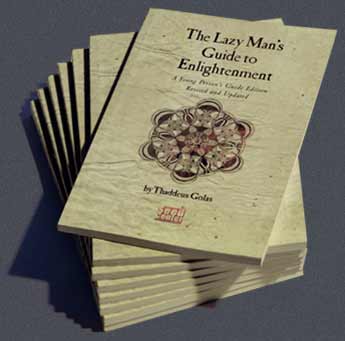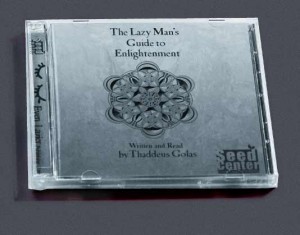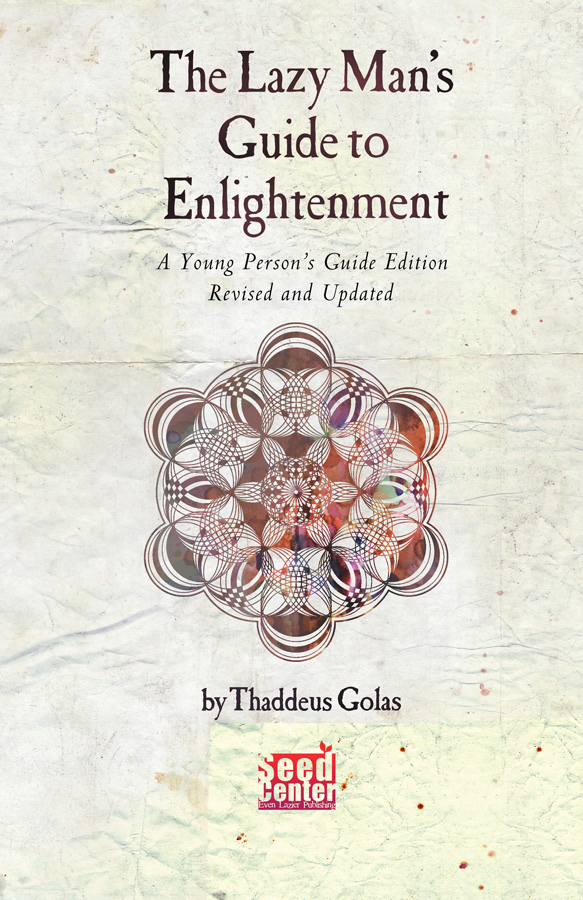(Updated, Corrected, and Revised by the Author) ©2008, Seed Center Books/The Collected Works of Thaddeus Golas Vol. 1
Thaddeus Golas updates his original text!
It is here; get your copy NOW!
First published in Europe, available from Seed Center Books UK, this final, definitive edition of The Lazy Man’s Guide to Enlightenment, also known as the Young Person’s Guide Edition, features 3 new and previously unpublished chapters, “EXPAND!”, “FREE WILL”, and “WHO’S ON FIRST?”, as well as an addendum to the book, “A Young Person’s Guide to Enlightenment,” with final conclusions offered by author Thaddeus Golas, as he paves the way for Love and Pain.
The Lazy Man’s Guide to Enlightenment (A Young Person’s Guide Edition)
Definitive, Complete, and Final edition, Revised and Updated by Author Thaddeus Golas ~ With 3 New and previously unpublished Chapters.
The Collected Works of Thaddeus Golas Vol. 1
By author: Thaddeus Golas Product Code: ccb-uk-001 ISBN: 978-2-7466280-5-2 Size: 5″” X 7.6″” Inches – 91 pages. Availability: Book in print/available
When late in life he revised and updated his text for a final Edition of the Guide, Thaddeus Golas chose to return the book to its original format, thin and unassuming, for a whole new generation of readers across the World. This is the most complete edition of The Lazy Man’s Guide to Enlightenmentto date.
Some of the subtle changes in the vocabulary were meant to sidestep references to LSD and avoid some outdated 60′s vernacular, but Thaddeus Golas had also wanted to bring minor fixes to some of his earlier assertions about energy — assertions which, over the years, he described as “slightly mistaken.”
It was those very changes in his paradigm that brought about the writing of Love and Pain, his follow-up book. 3 New Chapters are meant to help readers deepen their understanding of “expansion,” “contraction,” and the role of the intellect our spiritual progress. 
Also available from SEED CENTER BOOKS, author Thaddeus Golas reads The Lazy Man’s Guide to Enlightenment onto a special edition, double AUDIO CD.
Now you can hear the book from the mouth of the master himself!
Reviews: The Lazy Man’s Guide to Enlightenment. By Thaddeus Golas. Seed Center Books. California. ©2008, Even Lazier Publishing, Ltd. I AM Magazine, Quebec.
For those on the road still trying to thumb a ride, this book will show you how to make it on your own. There is no other way.
Being the lazy man’s lazy man, I quickly went to the last pages and back cover to glean the quintessential enlightenment offered in the excerpts. How can I be lazy and accelerate my vibrations to encompass all that wisdom in a flash, you may ask?
Chapter 7 answers that If you’re the kind of person caught up in sin, asceticism, rejection of earthly enjoyment, or other evidence of strict virtuous discipline, and are still having trouble being enlightened and in joy, this book is for you. It will shatter all your preconceived ideas about spirituality, If what you are doing isn’t working…love it and leave it. In other words: let go and let God. The Lazy Man’s Guide to Enlightenment lets you know you are already there. So what’s the point of arrival?
We exist on many levels simultaneously: from a being of concentrated mass (separateness, individuality), through energy being, to space being (oneness). How come, you may ask, most of us are only aware of the densest physical level? The answer is you can’t be anywhere else until you love yourself where you are now. After all, it’s a world of your own creation. As long as we reject anything we are tied to that one thing. Now that’s karma! The only effective way to be free of anything, is to love. Accept yourself where you’re at. If you hate or despise something, love yourself for despising or hating it. It’s the E=MC2 of the Universe. Be there, then. R.L.  A GUIDE to The Lazy Man’s Guide to Enlightenment. (A history of the little book, cliff notes, and highlights.)
A GUIDE to The Lazy Man’s Guide to Enlightenment. (A history of the little book, cliff notes, and highlights.)
The Lazy Man’s Guide To Enlightenment, was written as philosophical essay by Patterson New Jersey born American author Thaddeus Golas (1924-1997.)
Originally started as a series of notes in 1950, then a letter handed-out to friends, the book meandered through a first incarnation in 1968 as a mimeographed pamphlet called “Pleasure and Pain,” which Golas handed out on the streets of San Francisco. A copy found in the gutter made its way to Monday Night Class founder Steven Gaskin who later befriended Golas and had him as a frequent guest to his events.
Golas enjoyed interacting with people on the streets and engaging them on the topic of consciousness; he practiced the contents of his book on many a passerby before committing to the final writing. The book evolved and was eventually named The Lazy Man’s Guide to Enlightenment after Thaddeus Golas decided to lighten-up the language so as to make it as accessible to a large audience as possible.
By 1971, Golas decided that the confusion generated by psychedelic experiences and and the cacophony of budding New Age religions would be well served by a handy guide to spiritual levels. The book was officially published in 1972 by the son of an East Coast businessman, Joe E. Casey, but was quickly taken over by Palo Alto’s Seed Center in late 1972, after a dispute between Golas and Casey. The book sold briskly through many printings and was translated into many languages. It received notoriety as a legitimate work of metaphysics.
In 1979, it wound up at Bantam Books, where it blossomed and eventually reached the end of its run in 1993. In 1995, Gibbs-Smith Publishing of Utah, a publisher known mostly for interior decorating books, issued a limited hardcover edition of The Lazy Man’s Guide To Enlightenment. This edition included some photographs and an added introduction by Golas which served as a compendium of the author’s later thoughts and reflections about “The Guide“.
The Book:
The 80 page book is an original conception, unlike any other in the area of Spirituality and Philosophy, and has often been described as “the last book you’ll ever need to read on Spirituality.”
It contains many constructive warnings to readers about typical pitfalls associated with Spiritual Questing, and offers simple remedies for many forms of confusion often found in the field. It immediately was heralded as major philosophical work by Richard (Ram Dass) Alpert, and Alan Watts, who read passages from the pamphlet edition out-loud to their flocks.
Though the Guide inspired many to write spiritual books, it was a unique phenomenon for its time, and remains today. Golas purposely avoided discussing themes which had been covered by other spiritual authors, and focused instead on exposing his own ideas. Thaddeus Golas said he initially wrote The Lazy Man’ s Guide to Enlightenment as a sort of a life-raft for hippies who were drowning in the rough seas of the psychedelic era, but was soon stunned to discover that “the general public got off on it”.
Judging a Book and its cover:
The font originally used by the author for the text was Baskerville.
Thaddeus Golas, who worked extensively in publishing as a typesetter, proofreader, and production editor, felt strongly about clean and classic serif font, since “pretty” typefaces would loose their delicate serifs when printed on cheap paper. In 1975, DeRay Norton, his publisher at the Seed Center in Palo Alto, opted to have the typeface reset without telling Golas, after Norton was convinced by a printer to spend more money on a new font.
To his chagrin, Golas watched the subsequent editions of The Guide at Bantam Books, printed on cheap paper, and shot from the plates from the “Seed Center” edition. This proved his fears to be founded. The Bantam edition lacked the durability and the impact of the previous release.
Golas had even less control of the 1995 Gibbs Smith release.
While being a small high quality hardback edition, it lacked the dimensions of a pocketbook that could be carried in a backpack or hip pocket and referenced to easily, in a ‘cosmic’ pinch.
Foreign translations of The Guide were also problematic.
Golas’s concise style of writing and high minded concepts at times did not lend themselves to clear translation into some languages.
The Cover art of the Lazy Man’s Guide to Enlightenment, a curvilinear design is composed of circles in the style of a classic Russian folk mandala. The intersecting and overlapping circles may evoke the permeability of space, energy and matter. The font chosen by Golas on the cover of his book is a now defunct variant of a Caslon Old Face whose closest relative is presently Caslon Antique, or Casablanca Antique. Similar mandalas adorn the covers of Golas’s posthumous English language publications; Love and Pain a Map of Consciousness, and The Cosmic Airdrome.
All three mandalas were restored from traditional engravings by architect Klaus Rothe for The Seed Center.
In 2010 a European and Worldwide release by Seed Center Books brought the Guide up to date by incorporating revisions, with the subtitle “A Young Person’s Guide and Edition, The collected works of Thaddeus Golas Volume I”.
The book contains three extra, unpublished chapters that were written by the author in later years.
The title of the book is a nod to the fact that the author, a self-described “lazy man,” refuted the notion that a spiritual quest should demand “effort, non-smoking, strict diet, hard work, or other evidences of virtue.”
Quoting Zen, Golas asks “If you can’t find it where you’re standing, where do you hope to run in search of it”? In fact, Thaddeus Golas, in The Lazy Man’s Guide To Enlightenment, explains how in his view, even the effort of seeing the world as “needing to be purified” or people “as needing to be enlightened,” can easily lead one to erect a wall that can prevent a genuine gain from occurring in the opening perceptions that lead to a state of Enlightenment, or help maintaining it. 
Concepts within the Guide:
Thaddeus Golas, in The Lazy Man’s Guide To Enlightenment, also cautions against buying into the Spiritual Status system so typical of philosophical ideologues: “This can produce unloving snobbery towards your brothers,” he says, and reminds the reader that “what we see and describe is always ourselves.”
He adds “Many of our feelings about the world are based on erroneous perceptions about the status of others.”
Thaddeus Golas goes on to say that it is “pointless to worry about better or worse spiritual conditions beyond our own,” since “keeping our attention focused on the low vibrations of others fastens us to our own level.” Structures: that which dissolves from too much success or too much failure: Thaddeus Golas felt his most important chapter within the book was entitled “Self-Improvement.”
The segment discusses the survival of all structures, including the self, in relation to Spiritual questing. “A structure,” Golas says, “is any relation between entities that avoids dissolving.” He goes on to point out that “the self that we know is a structure…” “An odd thing about structures is that they will dissolve both from success and failure, too much pleasure or too much pain, so the problem, if you want a structure, is to maintain a tension somewhere between the two.”
Golas explains that the nature of all structures in our universe requires positive/negative or push/pull tension in order to avoid dissolution. He argues that in terms of spiritual questing, “the Ego feels better when it has to contend with the tension of threats to its survival.”
Hence the warning about seeking Spiritual Enlightenment through conventional methods: “Negative emphasis results in an intensified structure and a stronger ego. Even though some of these activities, like self-denial, are carried on under the banner of spiritual search, the result is the same.
On a subtle level we know that most spiritual endeavors will not succeed, but we go on maintaining the fantasy that they are admirable. Many of us have no intention of really succeeding in dissolving our attachment to structure and going to another plane of existence.” This paradox and its remedies are central to The Lazy Man’s Guide To Enlightenment.
Conversely in this same chapter, Golas specifically points the way toward dissolving the unwanted structures that have become useless and redundant habits that secure us to our present consciousness.
One must accept the present situation fully before being able to move beyond.
“Love it the way it is.” Golas contends that true love is probably the easiest, clearest (and laziest) path to higher consciousness. Meditation, psychedelics, yoga, asceticism, all have their place, but they can just effectively become “good games” over time. Love? Throughout The Guide, Thaddeus Golas continues to define the concept of love as a tool for self elevation.
In later writings, he emphasized “consciousness” over “love” after realizing that his readers had not always carefully read his own definition for “love” — “A behavior: synchronized vibrating – the willingness to be in the same space with others – the will to vibrate harmoniously with our neighbors in order to avoid pain.”
Since synchronized vibrating with our neighbors is potentially unstable or ephemeral, to the degree that we maintain our integrity, the lack of synchronization can lead to “inevitable pain” if we continue to be willing to have integrity.
Refusing to experience pain can cause us to endlessly adjust our behavior to maintain agreement with our neighbors – “love” – Refusing to modulate our vibrations for the sole purpose of maintaining agreement can lead to pain, but all transitions are painful; wanting to love at all cost can be binding, if it causes us to lose ourselves in the avoidance of pain – hence Golas’ motto: “be agreeable or go away!” – “Whatever you are doing, love yourself for doing it.” Love is a willing acceptance to be in the same space with others. “Love as much as you can from wherever you are”, “If you are not sure how to love, love yourself for not knowing.” While true love can allow an individual to raise consciousness at will, one also has to have the will or intention to get there. The author points out that many who take long arduous spiritual paths may have no serious intention of achieving enlightenment, because elevation often means vibrating out of sync with our environment.
How painful is a transition OUT of the physical realm? A commitment to the process can be as simple as an affirmation, a word or short phrase that is easily remembered. Golas gives many simple phrases throughout the guide and lists his favorites at the end.
Love and Pain: Love and Pain is the second book by Thaddeus Golas.
Wanting to make additions to The Lazy Man’s Guide To Enlightenment, and reexamine some of the issues presented with further clarity and the benefit of maturity, hindsight, and old age, Golas, in his later years, explored the idea that “too much pleasure or too much pain” would cause all structures to vanish.
He wrote extensively on the nature of consciousness from the idea expressed in this maxim.
He saw all interactions as oscillating between Pleasure and Pain in a search of the “Pleasure of Agreement.” He concluded that “perfect functional agreement” is impossible in our energy dimension, because “energy never rests, and never stops changing” thus, “our World was a constant rearrangement of the same variables…” “Good manners may be our best hope,” he said, “but we cannot fix the chaos.”
This thinking aligned him with several mystical traditions, including the Buddhist concept of dukkha which views the world as an endlessly delusional dream from which the soul would do well to escape, but placed him at odds with the New Age movement, which typically sees the world as a sort of Divine Playground whose apotheosis promises to deliver happiness and bliss.
Such resistance from the New Age industry kept his writing from being published.
Love and Pain, which explores these ideas, is published posthumously by Seed Center Books of California.  Space, Energy and Mass: In his “looking-glass” vision of Spirituality, the author brings the reader to the principal tenets of essential navigation through awakening to the transcendent nature within man.
Space, Energy and Mass: In his “looking-glass” vision of Spirituality, the author brings the reader to the principal tenets of essential navigation through awakening to the transcendent nature within man.
He navigates around common mistakes associated with many schools of spiritual dogma. At the core of The Lazy Man’s Guide To Enlightenment lies an idea discovered by Golas in 1950: “Space is to Energy as Energy is to Mass.”
This idea was inspired by reading a popular adaptation of Einstein’s General Relativity concepts. Thaddeus Golas begins The Lazy Man’s Guide To Enlightenmentwith a proposition:
- We are equal beings and the Universe is our relations with each other.
- Each being is alive.
- Each being determines the course of its own existence.
He goes on to suggest that “the function of each being is to expand and to contract.” Thaddeus Golas equated Space with Consciousness:”Basic entities are conscious space when expanded, unconscious mass when contracted, and alternating between these states as energy,” he noted.
A being has no set size or shape, but rather has a function: vibrating. A being’s appearance in the universe depends entirely on its vibration – “we are all beings” – whatever “we” happens to refer to at any given time.
In an ultimate state of expansion, “being” is permeable and all-inclusive, therefore, “being” is ONE, and includes all – in a contracted state of being, “being” is narrowed down to an impermeable sense of existing among other, equally impermeable beings being pushed together by space, and vibrating together in a general avoidance of pain.
Golas described: “There are two states of being: expanded and contracted. (It might be more precise to say standing momentum outward, and standing momentum inward, but those are awkward phrases to repeat often.) An entity must be in one state or the other at any given instant. It may sustain either state at will.
Expanding consciousness is not a process of expanding like a balloon, it is a process of PROLONGING your conscious state.
You must be either conscious or unconscious in any given instant”.
Energy: The role of Energy is central to Thaddeus Golas’ philosophy. He felt that the term “energy” is frequently used in metaphysical discussions despite being wholly misunderstood.
In his later revisions of The Lazy man’ s Guide to Enlightenment and in much of his subsequent writing, Thaddeus Golas emphasized the importance of understanding the role played by the “seduction” of Energy in our interactions on the material plane…
The very “glue” which holds matter together is also seen as the chief culprit in the delusion experienced by consciousness when it is bound in Spacetime, according to Golas.
“Energy is the rapid alternating between space and mass”, Golas explained, “the devil, the delinquent, the messenger who delivers only half the message, the marker of time.” There are only two states: Expansion (Space/Consciousness/a tendency toward diminishing vibration) and Contraction (Mass/Unconsciousness/a tendency to accelerating vibration) — Energy is the alternating flux between those two states and IS the universe as we know it — fleeting — self sustaining — and “flickering” at an incredibly high rate of speed (what is described in physics as wave-particle duality.)
What does this have to do with the spirit, Golas asks? Simply that consciousness (space) has the singular function of pushing away all vibrating energy and subsequent mass (unconsciousness) in a uniform manner. Clearly grasping the consequences of this objective, non-directive action upon all vibrations can help us understand the role of free will in our predicament as material creatures.
It can also help us avoid to wrongly attribute functions to consciousness such as the supposition that it controls or manipulates our interactions as the material universe – in other words: we are where we are among our equals, because of our own vibration level – nothing is compelling us and we are free to change our vibration so we can join with others who vibrate differently.
There is no “good” or “bad” energy, according to Golas, since energy is what we are all doing when we are not “being space.” He coined the notion that: “Space propels energy, and energy compels matter – the propulsion is uniform; it is what we now call the force of gravity”.
The book essentially discusses our lives from that viewpoint.
Was it all just about LSD?
Thaddeus Golas used LSD during the late sixties and early seventies.
He continued to write enthusiastically about its properties, long after he ceased taking the drug itself in 1971. He credited LSD for helping him crystallize his ideas on the physics of metaphysics, but disliked the notion which many proposed, that The Lazy Man’s Guide To Enlightenment was in some way channeled, or resulted from automatic writing spell in an altered state of consciousness.
Of that, he said: “I resented being seen as some sort of typist for higher consciousness.” Golas enjoyed discussing his tangible and down-to-earth reasons for bringing forth his book as he did, and spoke of having his first satori experience almost a decade before he ever used psychedelics; he often said his ideas evolved over a 30 year period.
He was proud of his intrinsic qualities as a writer, and appreciated being recognized for his earthbound human skills, and his clarity of thinking. He often said that throughout his life, he was denied simple credit for his ideas, on many occasions…
The New Age:
Golas over time observed the many phenomenal tides and fashions that came out of the sixties and eschewed much of them.
While Mysticism, Astrology, Witchcraft, Shamanism, Clairvoyance, Manifestation do have phenomenological relevance, he contends that these practices place far too much emphasis on manipulating energy for some extension into the physical realm. Throughout Golas’ writings, he asserts that one possible use of this knowledge might be to have the choice to leave this reality, to get off the wheel of life rather than trying to gain some power over it.
According to Golas, energy manipulation, whether physical or spiritual, will always prove to be unreliable in the end. “You cannot use energy to get to Heaven,” he offered, “you get to Heaven by CEASING to be energy.”
Updates and revisions: Thaddeus Golas made revisions to the original text of The Lazy Man’s Guide to Enlightenment throughout the 1980s and 1990s.
Such revisions were intended to help the text survive the extinction of the 1960s jargon. He also clarified many concepts and emphasized the idea that consciousness expansion, more so than love, is the key to Enlightenment.
A new version of the book, containing three new chapters and small ‘fixes’ has been released Internationally in 2011. 
Foreign editions: There are, to date, seven officially sanctioned translations of The Lazy Man’s Guide to Enlightenment. Though not all are currently in print, the latest member in the family is a French edition. It features the most recent version of the Guide, that includes three new chapters, “Expand!, Free Will, and Who’s on First?”
Click on the books (below) to obtain the new French language edition:


